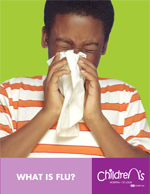
What is Flu?
The flu is a contagious respiratory illness caused by influenza viruses. It can cause mild to severe illness and at times lead to death.
Flu Symptoms
Flu attacks the respiratory tract in humans (nose, throat and lungs). The flu is different from a cold. Flu usually comes on suddenly and can include these symptoms:
- Fever
- Tiredness (can be extreme)
- Sore throat
- Body aches
- Headache
- Dry Cough
- Nasal congestion
These symptoms are usually referred to as “flu-like symptoms,” and typically do NOT include gastrointestinal symptoms such as nausea, vomiting or diarrhea.
How Flu Spreads
The flu is spread in respiratory droplets caused by coughing and sneezing. It usually spreads from person-to-person, though occasionally a person may become infected by touching something with virus on it and then touching his or her own mouth or nose.
Adults may be able to infect others beginning one day before getting symptoms and for up to seven days after getting sick. That means you can give someone the flu before you know you’re sick, as well as while you’re sick.
Complications
Young children and people with certain health conditions are among those at higher risk for serious flu complications.
The flu can cause sinus problems or ear infections in children. Other complications caused by flu include bacterial pneumonia, dehydration and worsening of chronic medical conditions such as congestive heart failure, asthma or diabetes.
Is it a Cold or the Flu?
Influenza (flu) is like a cold in many ways – basically, they’re both respiratory infections caused by viruses. If a cold is misdiagnosed as the flu, there’s no harm. At worst, a cold can occasionally lead to secondary bacterial infections of the middle ear or sinuses, which can be treated with antibiotics. But, if the flu is misdiagnosed as a bad cold, potentially life-threatening flu complications, like pneumonia, may be overlooked.
Some of the symptoms of a cold and the flu are similar, but the two diseases can usually be told apart. Child your symptoms and ask your medical provider for advice.
|
Symptoms |
Cold |
Flu |
|
Fever |
Rare in adults and older children, but can be as high as 102ºF in infants and small children |
Can be minimal or as high as 104° and can last 3-4 days. |
|
Headache |
Rare |
Sudden onset and can be severe |
|
Muscle aches |
Mild |
Usual and often severe |
|
Tiredness and weakness |
Mild |
Can last 2 or more weeks |
|
Extreme exhaustion |
Rarely |
Sudden onset and can be severe |
|
Runny nose |
Often |
Sometimes |
|
Sneezing |
Often |
Sometimes |
|
Sore throat |
Often |
Sometimes |
|
Cough |
Mild hacking |
Usual and can become severe |
But what about nausea, vomiting and diarrhea? You hear about those symptoms all the time, but they are not symptoms of the flu. If you are experiencing nausea, vomiting or diarrhea, you probably do not have the flu. You likely have a stomach virus known as gastroenteritis.
Preventing the Flu – What You Can Do to Stay Healthy
- Get a flu vaccine every year.
- Stay informed. Follow the latest news from reliable sources such as the Centers for Disease Control and Prevention (CDC) and the World Health Organization (WHO).
- Avoid touching your eyes, nose or mouth – germs enter your body this way.
- Avoid close contact with people who are sick.
- Stay home if you get sick to prevent others from catching your illness.
- Follow public health advice regarding school closures, avoiding crowds and other social distancing measures.
- Other good habits, such as getting plenty of sleep, exercising regularly, drinking plenty of water and eating healthy foods, will also help you stay healthy.
- Practice Good Cough and Sneezing Etiquette:
Cough and Sneezing Etiquette:
|
Treating the Flu
- Get plenty of rest.
- Drink plenty of liquids (water, soup, tea, etc.)
- Avoid use of alcohol and tobacco
- Take medications to relieve the symptoms (cough suppressants, nasal decongestants, fever and pain relievers.)
- Do NOT give a child aspirin!
- Talk to a doctor are antiviral medications
- Do not take antibiotics. They do not cure the flu.
- Avoid close contact (hugging, kissing, shaking hands, drinking from the same cup) with others.
- Stay home from work, school, church, sporting events, libraries, shopping centers, grocery stores, restaurants, etc.
- Clean your hands frequently and use a fresh tissue every time you blow your nose, cough or sneeze. Safely dispose of the tissue right away and clean your hands immediately.
What to do if you have flu-like symptoms and…
…you are NOT at high-risk for complications* -- Stay home until your fever is gone for 24 hours without using medicine. Don’t go to a hospital. Call your medical provider if concerned
…you ARE high risk-for complications*-- Call your medical provider right away to discuss antiviral medicines and whether a visit is needed.
…you are having severe illness, like difficulty breathing, regardless of whether you are high-risk. --Call 911 or go to a hospital right away. Tell them you may have influenza.
*People at high risk of flu complications include people under the age of 2 or over the age of 65; people under 19 years of age on long-term aspirin; people on chronic pulmonary (including asthma), cardiovascular (except hypertension), hepatic, hematological (including sickle cell), neurologic or metabolic (including diabetes) disorders, people who are immunosuppressed (HIV, transplant), and pregnant women.










